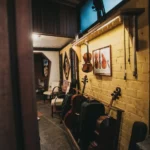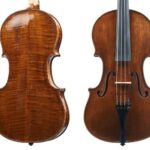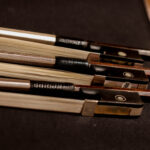The Facts You Didn’t Know About the Violin Bow
Back to BlogLike everything in life, if you genuinely want to understand it, you must look at history. With violins and the violin bow, it’s no different, and it is actually very interesting!
Bows for violin and other stringed instruments have been made in a variety of ways over the centuries. In the same way, luthiers get inspiration from makers to build a violin. The skilled craftspeople who create them today also use techniques developed by the bow master makers from the past!
While the design of a violin bow may seem like a simple and unchangeable object, it has evolved quite a bit to become what we see today. From the simple piece used in the middle ages to the masterpieces created today, the violin bow history is much more interesting than it seems.
The Mid-fifth century Violin Bow
Some bows date from the mid-fifth century; these primitive bows were very similar to the archery bow. Nothing like the way it is done nowadays, they were crudely made with the horsehair being fastened directly to the stick and shorter, only about 20 to 30 centimeters in length.
“The very earliest bows were simply dowels with horsehair attached to the tip of the stick through a slit.” points out The Strings Magazine’s post.
Fun fact: The violin bow came first. These bows were used to play other ancient instruments, as our violin hadn’t been invented at that time; it only came later.
It’s in the Baroque Era it started to look more like an instrument tool
In the early baroque era, the playing techniques improved and developed the bow structure for the first time. But little was changed because the French Baroque music was similar in style to Renaissance dance music.
Later, the height of the head was increased to distribute weight more evenly and achieve playability along the entire length of the bow. The convex curve of the bow lessened until a bow that was slightly straight to concave had evolved.
The bow design from the Baroque Era credits to Arcangelo Corelli (1653-1713), who was the one that made significant and fundamental changes; its aural ideal came to resemble that of singing more and more. For instance, the introduction of a longer violin bow triggered a series of changes in construction, especially an increase in the height of the head so as to achieve better playability. The fewer arch bows eventually became more popular between the players.
The Classical Bow
The bow was only fully transformed at the end of the 18th century. The classical era was a transitional one for bows. The major violin soloists favored the “Cramer bow” (named after the violinist Wilhelm Cramer). It had a characteristically high and hammer-shaped head, a clip-in frog, and a solid concave stick. The hair ribbon on this bow was wider than the Corelli model bow but was still narrow compared to that of a Tourte.
Firstly, let’s talk about Giovanni Battista Viotti, this Italian violinist had a very important role in the history of the bow, as important as Arcangelo Corelli did. Under his influence, the key developments of the violin bow were made, which later led to the modern violin bow model. Of course, he wasn’t alone, legendary soloists such as Rodolphe Kreutzer and Niccolò Paganini also did their part.
Christian Wilhelm Knopf invented an underslide of metal, thereby eliminating a critical weak point in the screw mechanism of Baroque bows, whereas John Dodd improved the breaking strength of the stick by introducing a new technique for splitting wood. Later François Xavier Tourte came, revolutionizing and designing the style of the Classical violin bow, resulting in a new era in violin bow making.
François Tourte, one of the biggest names in violin bow making
Francois Tourte started working on the craft of violin bows around 1785 and 1790, and much of his work was very innovative and left features to the modern bows.
He was the son of a luthier (Nicolas Pierre Tourte) but initially apprenticed as a watchmaker. Shifting to bowmaking in collaboration with violin virtuoso G. B. Viotti, he improvised upon the supporting instrument.
He worked with the great violin virtuoso Viotti to change the design and structure of the bow. It is also said the modern bow was created primarily by the Tourte brothers and their father.
As time progressed, his work, especially during his ‘golden period’ after 1800, became the model for the modern bow that has been emulated ever since. Nowadays, his bows command the highest prices for their extraordinary craftsmanship, elegance, and appreciation by players.
Some characteristics of Tourte violin bows:
- Tourte lengthened the bow
- Used more wood in the tip, counterbalancing the heavier nut.
- He introduced premium pernambuco wood
- Tourte used mathematics to calculate the best proportions for the bow.
- His bows were longer than in the Baroque era.
- Few of his works were signed, and most of the credit at the time went to his collaborating virtuoso.
- Tourte bows were well balanced and had a quick and agile response
- He took great care with how each part was designed, tasteful touches like the head’s contours and the horsehair’s mounting.









